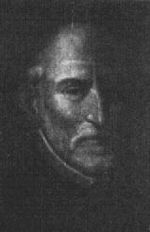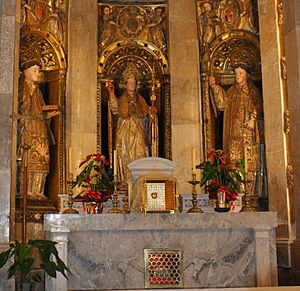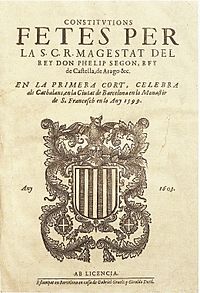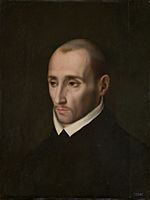Joan Terès i Borrull facts for kids
Quick facts for kids Joan Terès i Borrull |
|
|---|---|
| Archbishop of Tarragona, Spain | |
 |
|
| Church | Catholic Church |
| Appointed | 22 May 1587 |
| Reign ended | 10 July 1603 |
| Predecessor | Antonio Agustín y Albanell |
| Successor | Juan Vich y Manrique de Lara |
| Other posts | Viceroy of Catalonia (1602-1603) |
| Orders | |
| Ordination | 4 February 1975 |
| Personal details | |
| Birth name | Joan Miquel Terès i Borrull |
| Born | 29 September 1538 Verdú, Spain |
| Died | 10 July 1603 Barcelona, Spain |
| Buried | Tarragona Cathedral |
| Nationality | Spanish |
| Denomination | Catholicism |
| Residence | Palace of the Lieutenant |
| Parents | Joan Terès Domènech Magdalena Borrull Carnicer |
| Previous post | Rector of the University of Valencia, Spain (1570) Bishop of Morocco, Spain (1575-1579) Rector of the University of Tarragona, Spain (1577-1579) Bishop of Elne, Spain (1579-1586) Bishop of Tortosa, Spain (1586-1587) |
| Alma mater | University of Valencia |
| Motto | Virtute Huius Omnia Teres |
| Coat of arms |  |
Joan Terès i Borrull (born September 29, 1538 – died July 10, 1603) was an important Spanish church leader. He served as a presbyter (a type of priest) in Vic. He was also an auxiliary bishop for Morocco, then a bishop for Elne and Tortosa. Later, he became the archbishop of Tarragona.
Besides his church roles, Joan Terès i Borrull was also the viceroy of Catalonia from 1602 to 1603. He was also an advisor to King Philip III of Spain.
Contents
Early Life and Education
Joan Terès i Borrull was born in Verdú, Spain, in 1538. His family was humble, meaning they didn't have much money. He was one of five children.
As a teenager, he lived in Reus and studied grammar. He often had to beg to pay for his schooling. In 1554, he moved to the School of Tarragona. There, he studied Latin and other subjects, earning money by delivering letters.
Because he was very talented, he received help and encouragement from others. He was sent to study philosophy and theology at the Saint Paul School in Valencia. This school was founded by the Society of Jesus, also known as the Jesuits. He completed his advanced studies there.
Life as a Professor
Joan Terès i Borrull became a professor at the University of Valencia. In 1566, he asked for more time to pay for his doctorate in theology, which was approved. He likely passed his exams on his first try.
From 1566 to 1572, he taught different subjects like Logic and Philosophy. He was a dedicated teacher and examiner at the university.
In 1570, the archbishop of Valencia, Juan de Ribera, appointed Joan Terès as the new rector of the University of Valencia. This happened when the previous rector was removed from his position. The archbishop wanted someone from the Jesuit order to lead the university. Joan Terès was a good choice because he had studied at the Jesuit School of Saint Paul.
One of Joan Terès's students was the Spanish philosopher Diego Mas. Diego Mas dedicated two of his books to his former teacher:
- Metaphysica disputatio seu de ente et de eius propietatibus, quae communi nomine scribitur de trascendentibus (Valencia, 1587)
- Commentaria in Universam Philosophia Aristotelis, una cum quaestionibus quae a gravissimis viris disputari solent (Valencia, 1599)
Becoming a Church Leader
After his time at the university, Joan Terès returned to Tarragona. He received a special position at the cathedral of Tarragona. This helped him live comfortably without money worries.
In 1570, the archbishop of Tarragona, Gaspar Cervantes de Gaeta, became a cardinal. When the cardinal moved to Italy, Terès took care of the church matters in the Tarragona area.
On February 4, 1575, Archbishop Cervantes made Terès a bishop. That same year, the Seminary of Tarragona was founded. It was the first seminary in Spain, following new church rules. Terès became its first rector. Later that year, the Pope agreed to make him an auxiliary bishop for Morocco.
In 1577, the University of Tarragona was officially started. On May 2, Terès was appointed rector of this new university. He also taught theology there.
In 1579, Pope Gregory XIII sent him to lead the diocese of Elne. He started his new role on July 26. In 1582, he met Maria of Austria, the Empress, and her daughter when they visited Elne. He even led a special mass for them.
In 1586, he became the bishop of Tortosa. As bishop of Tortosa, he blessed the church in his hometown of Verdú. On May 22, 1587, Pope Sixtus V made him the archbishop of Tarragona.
Archbishop of Tarragona
As archbishop, Joan Terès founded the monastery of Saint Dominic in Ciutadilla in 1588. He also helped improve other monasteries and hermitages.
In 1589, he helped Tarragona get a special right from Philip II of Spain to be a Studium Generale. This meant it could be a major center for learning, like a university. The city celebrated this news with great joy.

In 1592, Terès ordered the building of two new chapels in the Tarragona Cathedral. These were the chapels of Saint John the Evangelist and Saint Fructuosus. He hired the famous architect Pere Blai for this work.
In 1592, Pope Clement VIII issued a special order. This order changed how some monasteries in Catalonia worked. The Pope asked Archbishop Terès and other church leaders to make sure this order was followed.
One monastery, Saint Mary of Solsona, at first resisted the order. But later, the people of Solsona asked King Philip II to create a new diocese (church area) with Solsona as its main city. The Pope and King agreed. Archbishop Terès helped set up this new diocese.
In 1594, Terès traveled by ship to the island of Ibiza. On the way, his ships were attacked by pirates. But the archbishop's ships fought back and captured two pirate ships.
He supported several religious orders, like the Capuchins, Augustinians, and Carmelites. He also greatly improved the monastery of the Jesuits. As archbishop, he led several important church meetings.
In 1596, Terès helped with the process to recognize Raymond of Penyafort as a saint. He also supported the process to make Ignatius of Loyola, the founder of the Jesuits, a saint.
Viceroy of Catalonia
In 1599, King Philip III of Spain attended a meeting of the Catalan Courts. Archbishop Terès was there, representing the church. During these meetings, there were some disagreements, especially about the power of the viceroy and about people carrying dangerous firearms called petronels.
The viceroy at the time, Lorenzo Suárez de Figueroa, caused problems by arresting some officials. Because of this, he was removed from his position. On April 16, 1602, King Philip III chose Joan Terès to be the new Viceroy of Catalonia.

The king chose Terès because he was well-known and respected, and the king hoped he could bring peace. Terès released the officials who had been arrested. He also worked to publish the laws of Catalonia. He was very against the use of petronels, especially because many people were being killed by them. He even tried to stop blacksmiths from making them.
As viceroy, Terès also got involved in local disputes between different groups. He was eager to return to his church duties. So, he asked the king to find someone else to be viceroy. King Philip III agreed, and a new viceroy was appointed in May 1603.
Death and Legacy
Before he could hand over his powers to the new viceroy, Archbishop Terès died on July 10, 1603, in Barcelona. He was 64 years old. The reasons for his death were not clear, and some people thought he might have been poisoned.
In 1610, his body was moved to Tarragona. He was buried in the Tarragona Cathedral, between the chapels of Saint Fructuosus and Saint John.
Joan Terès i Borrull was known for his generous spirit. He left money to help unmarried women in his family. He also provided funds for students at the Seminary of Tarragona, especially poor students from his family or from certain towns. He also helped other poor students who wanted to become priests. Finally, he set up a fund to help three chosen girls each year from Tarragona and nearby towns.
He is also remembered for helping two orphanages in Tarragona, one for boys and one for girls. A street in his hometown of Verdú, Spain, is named after him.
See also
 In Spanish: Juan Terés y Borrull para niños
In Spanish: Juan Terés y Borrull para niños


